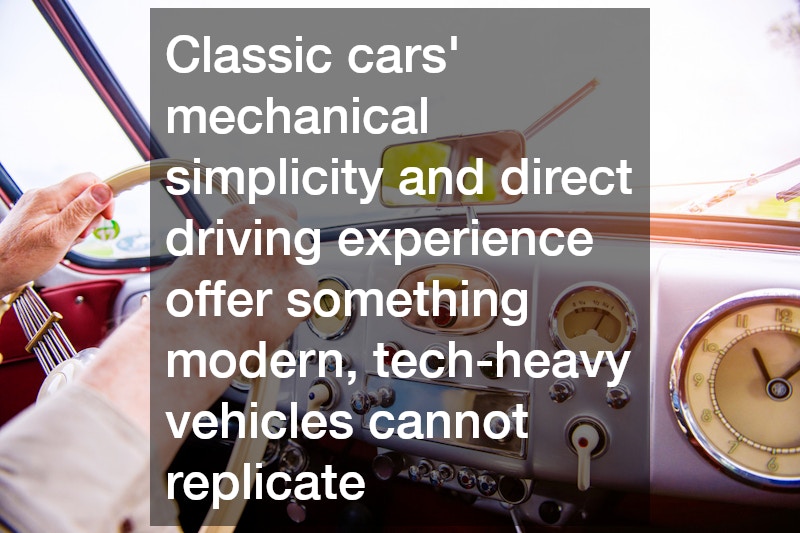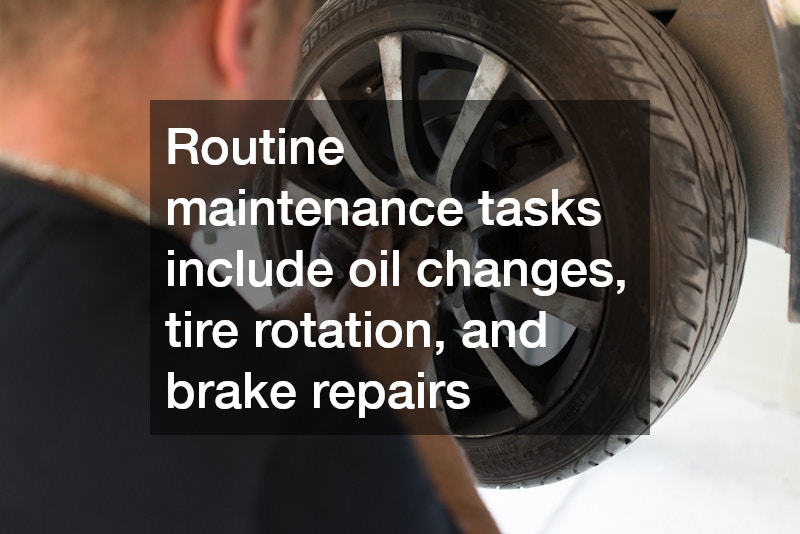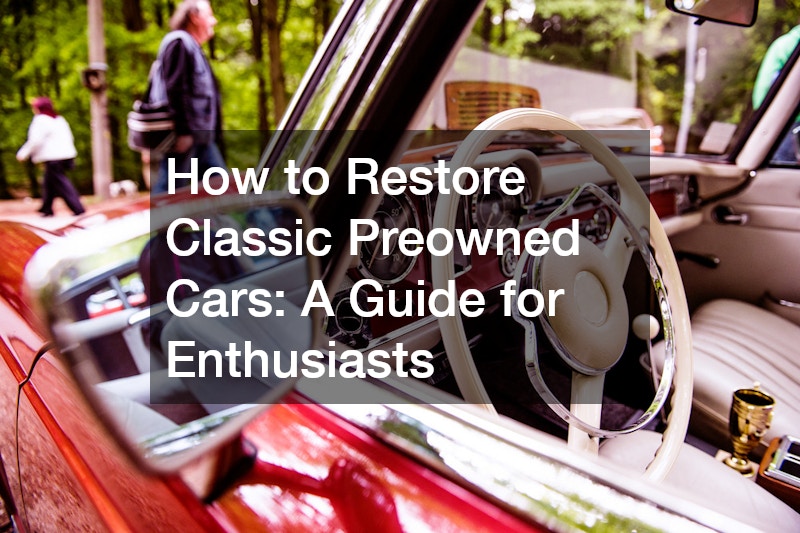Classic cars are a timeless style that appeals to all generations. These cars, which are often called “timeless beauties,” feature unique designs, unmatched workmanship, and a rich past that continue to appeal to car lovers worldwide. Those who love cars will find that restoring and buying a classic used car is both an exciting project and a worthwhile investment. This article explores the world of pre-owned classic cars, and provides comprehensive advice on how you can restore and maintain them.
What Defines a Classic Car?
Understanding ‘Classic’ in the Automotive World
A “classic used car” is a vehicle with a history or design that has been significant for at least 20 years. Classic cars are often a throwback to a bygone era of automotive style and innovation. Classic cars are admired not only for the unique looks, but also because they tell a story about an industry that has evolved through ingenuity and craftsmanship.
Classic cars can take many forms. Whether it’s an old convertible from the 1960s, or a 1970s muscle car, they all have their own charm. Automotive organizations and enthusiasts often recognize the “classic” designation, with some cars being recognized as collectors’ items.
The Importance of Age and Historical Significance
The age of a car is the primary factor in defining it as a classic. A car is considered “classic” if it’s at least 25 years of age. However, its historical significance plays a part as well. Pre-owned classic cars are often symbols of an era, as they were part of significant periods in automotive design and technological advancements. These cars, whether it is the sleek lines and bold design of the 1957 Chevy Bel Air or the 1965 Mustang, evoke nostalgia. They are pieces of history in motion.
The Allure of Classic Design

Classic cars have an undeniable appeal. These vehicles are often designed with curves and chrome to give them a boldness that is lacking in modern cars. Many enthusiasts are drawn to the unique design and to driving a vehicle that is different from those of today. Beyond their looks, classic cars’ mechanical simplicity and direct driving experience offer something modern, tech-heavy vehicles cannot replicate.
Where to Find Your Perfect Classic Car
Reputable Dealers and Trusted Online Marketplaces
Knowing where to look is important when searching for a pre-owned classic car. The best places to begin your search are reputable dealers and online marketplaces. Classic car enthusiasts are often drawn to local dealers who specialize in vintage cars or online platforms like Hemmings.com, ClassicCars.com, and Bring a Trailer. These sources provide detailed listings, which makes it easier to locate the perfect vehicle.
If you are buying from an auto dealer in your area or a marketplace online, make sure that the seller is reputable. Check reviews, look for certifications and don’t be afraid to ask about the vehicle’s past and current condition.
The Importance of Vehicle History Reports
When buying a classic vehicle, a detailed report on the car’s history is necessary. These reports provide information about the past of the vehicle, such as ownership history, collision records, and title status. It is important to check the history of any classic car, especially if it has been through several owners. You can gauge future repairs and maintenance costs by knowing the service history and vehicle accidents.
Negotiating the Best Price
The price of an old classic car depends on its make, model and condition. Knowing the value of the car and being ready to discuss restoration costs are important factors in the negotiation. Negotiating lower prices is not unusual if the car has cosmetic or mechanical problems. Be prepared to pay more for highly desirable or rare models in perfect condition.
Common Challenges in Classic Car Restoration
Engine and Transmission Troubles
When restoring an older classic car, owners often face transmission and engine problems. Due to their age, these components may be affected by wear and tear. These vehicles require thorough inspections to ensure they are safe for the road. Due to the high stress that engines and transmissions can cause, performance cars, especially those that have been used as racecars in the past, may need extra attention.
Electrical System Concerns
Another area to be concerned about is the electrical systems of classic cars. Over time, the wiring in these cars may become corroded, causing shorts or failures to occur in the lighting, ignition or radio systems. Some modern electrical components are not compatible with older vehicles, so owners may need to find vintage parts or specialized mechanics that understand these outdated systems.
Assessing Body and Frame Integrity
When restoring an older car, the body and frame must be in good condition. Older cars are often plagued by rust, corrosion, and dents. You can determine the type of repair required by thoroughly inspecting your car’s body, especially the frame. Some cases may require specialized welding or even part replacements to restore the vehicle to its former glory.
Your Step-by-Step Guide to Restoring a Classic Car
Creating an Effective Restoration Plan
A plan should be created before you begin the restoration process of an old classic car. The plan should include all the steps, including sourcing parts and scheduling services such as car stereo installation or painting. You should research the model to determine what parts are in need of replacement, what can be restored and if you want to customize the car.
Sourcing Parts for Your Project
Finding the right parts is one of the most difficult aspects of restoring an old car. Parts may have to be purchased from online marketplaces or specialized shops depending on the rarity and age of the car. You can also search for parts in classic car swap meet or auctions. Many enthusiasts use forums or vintage parts retailers to find the parts they need for their projects.
Techniques for Bodywork and Painting
Restoring an old classic car can involve extensive bodywork, including painting. Many owners hire a local auto-body shop that specializes on vintage cars to achieve the perfect finish. These professionals can fix dents, rust and scratches, and paint the car in a color that matches your original choice or one of your choosing. The bodywork can be one of most challenging aspects of a car restoration, but also the most rewarding. It can transform the appearance of your vehicle.
Interior Restoration Essentials
The interior of an older classic car should be restored as well as its exterior. Seats, dashboards and carpets are often in need of replacement or reupholstery. Modern technologies such as GPS tracking systems can be installed discreetly for safety while upgrading your car stereo can improve the driving experience. When it comes to getting the interior of your car back to showroom condition, working with a professional detailer can be beneficial. They will ensure that all the little details are taken care of.
Essential Tools for Restoration Success
Basic Tools Every Enthusiast Needs
Every car enthusiast needs a basic set of tools to restore a classic. These include wrenches, screwdrivers, pliers, and socket sets. These tools are necessary for many repairs. However, some projects require more advanced equipment.
Specialized Equipment for Detailed Restorations
Specialized equipment, like hydraulic jacks, sanders, and paint guns, may be required for more complex restoration projects, such an engine overhaul or bodywork. Some classic car models may also need specific tools to adjust brakes or tune carburetors.
Recommended Brands for Quality Tools
It’s crucial to use high-quality tools when restoring an older car. Brands such as Craftsman Snap-on and DeWalt are trusted for their durable tools and are known for their precision, strength, and reliability. The restoration process will be easier and more enjoyable if you have the right tools.
Exploring Electric Conversion for Classics
Hybrid and Electric Conversions Explained
Some classic car owners have begun to explore the option of converting older vehicles into electric or hybrid vehicles as electric vehicles gain in popularity. This can be a fun way to modernize a classic used car. However, such conversions require specialized technical knowledge and are not for the novice.
Pros and Cons of Going Electric
Converting an old car into an electric version can reduce emissions and fuel consumption, thereby making it environmentally friendly. The conversion process can be expensive and affect the originality, which may impact the value of the car for collectors.
Navigating Technical Challenges
The electrical and powertrain systems of a vehicle must be modified significantly to make an electric conversion. Even the most experienced mechanics can find these technical challenges daunting. It’s best to consult a specialist with experience in both electric and classic vehicles.
Maintaining Your Classic Car for Longevity
Regular Maintenance: A Must for Classic Cars

Regular maintenance is essential to keep a classic car in top condition. Routine maintenance tasks include oil changes, tire rotation, and brake repairs. In order to avoid unexpected breakdowns, classic cars also benefit from regular inspections of their fluids, belts, and hoses.
Tips for Seasonal Care and Proper Storage
Classic cars are more susceptible to extreme temperatures and moisture. Therefore, seasonal care is important. If you live in a region with humid summers and harsh winters, it is advisable to store your car in a climate-controlled environment.
Preserving Paint and Upholstery
Regular cleaning and waxing are essential to preserve the paint and upholstery of your car. Professional detailing can maintain the appearance of your car, and specialized products for vintage cars can prevent the exterior or interior materials from fading, peeling, or cracking.
Insuring Your Classic Car Effectively
Understanding Classic Car Insurance Policies
Classic pre-owned cars need specialized auto policies that are tailored to their value and risk. Classic car insurance is different from standard auto insurance because it takes into consideration the car’s history, its limited usage, and any potential appreciation.
Evaluating Coverage Options
It’s important to compare different options when insuring an older classic car. Some policies include agreed value coverage where both the insurer and the owner agree on the value of the car, while other policies may offer market values coverage which is adjusted based on recent sales data.
Driving and Enjoying Your Classic Car
Handling Tips for Safe Driving
Driving a classic vehicle requires a completely different approach than driving a modern car. Because these cars lack safety features like anti-lock breaks and traction controls, it is important to drive defensively and at a safe speed.
Protecting Your Investment on the Road
It takes more than careful driving to protect your classic used car. Regular maintenance, including the use of protective paint coatings, can help protect your car from damage caused by road debris and weather conditions.
The Joy of Car Shows and Community Events
Joining car shows and events is one of the best ways you can enjoy a classic used car. These events allow car enthusiasts to display their restorations, and connect with other vintage vehicle enthusiasts.
Evaluating Classic Cars as Investments
Market Trends and Future Potential
Some models of classic pre-owned cars have appreciated significantly in value over the years. Market trends indicate that classic cars, especially those of historical significance or rarity and that are well-maintained, will command high prices.
Factors Influencing Valuation
The value of a classic vehicle is influenced by several factors, such as its make, condition, and originality. Cars that have been heavily modified tend to be more expensive than those in original condition.
Financial Benefits of Investing in Classics
A classic car investment can be financially rewarding, especially if it appreciates in price. Classic cars are often cheaper to run than newer vehicles. They can also qualify for insurance discounts and tax breaks through special policies.
Restaurating and maintaining pre-owned classic cars can be an enjoyable hobby and investment. Understanding their uniqueness, challenges, and potential allows enthusiasts to enjoy the nostalgic experience that these vehicles provide. You can own a classic pre-owned car by acquiring parts at a local dealer, using carport services, or hiring a detailer.
Classic cars are a timeless style that appeals to all generations. These cars, often called “timeless beauties,” have unique designs, unmatched workmanship, and a long history that continues to appeal to car lovers worldwide. Those who love cars will find that restoring and buying a classic used car is both an exciting project and a worthwhile investment.
